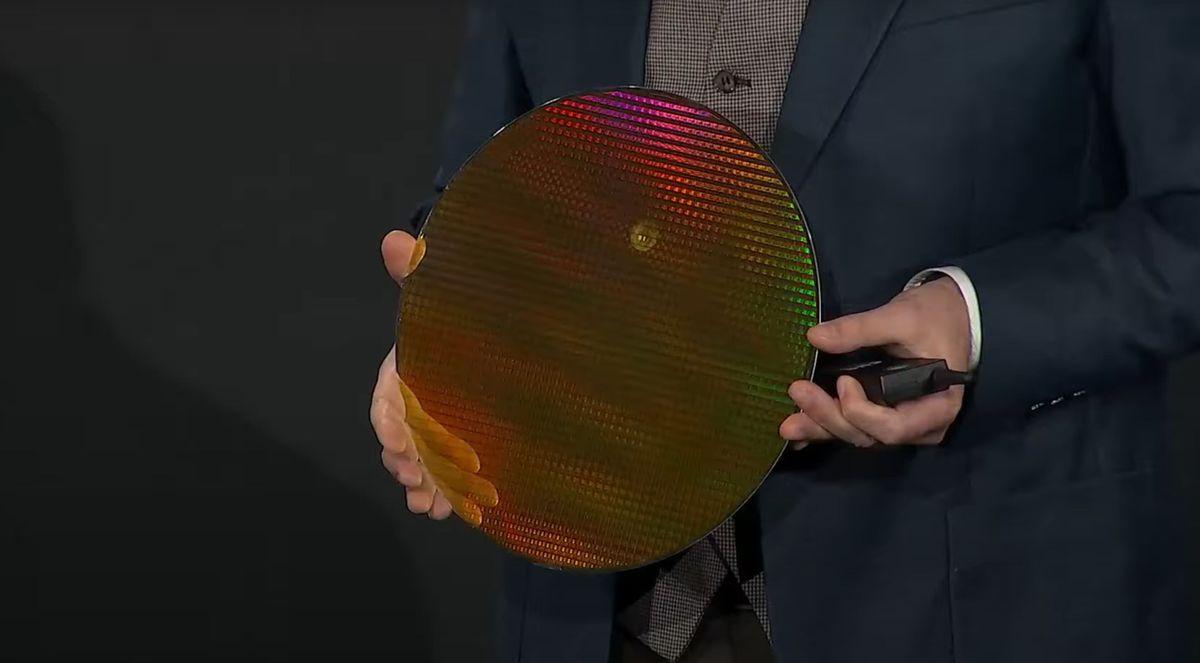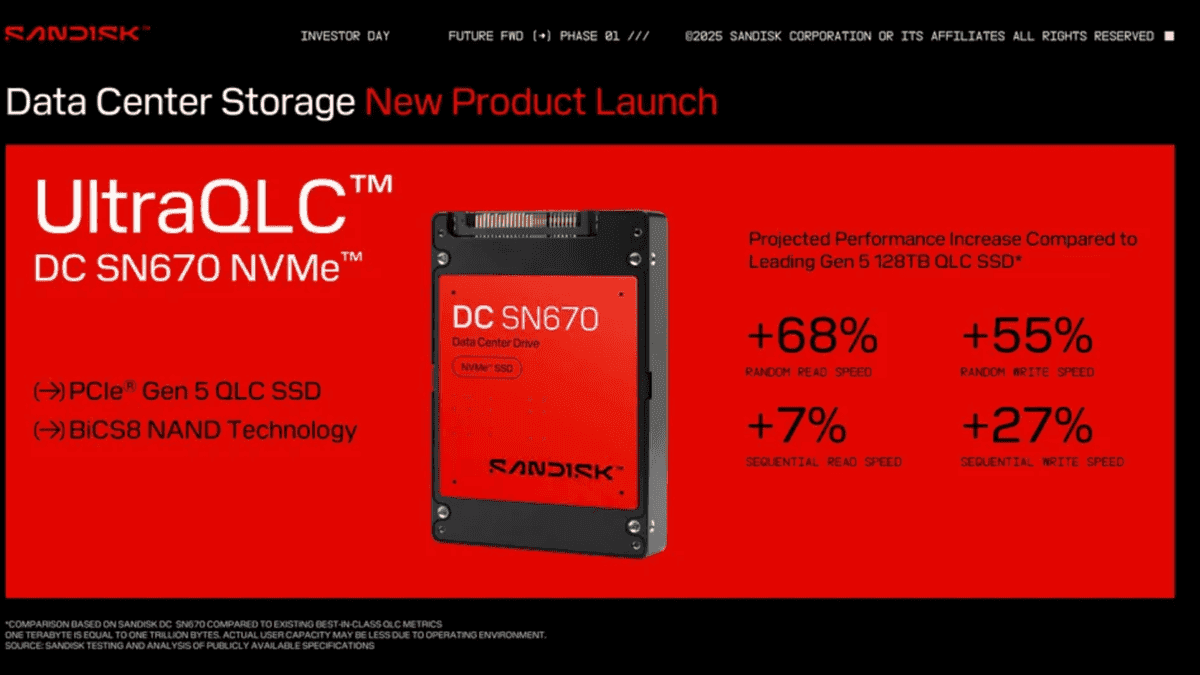SK Hynix Pioneers 321-Layer QLC NAND: A Leap Forward in Storage Technology
4 Sources
4 Sources
[1]
Consumers to benefit first as SK Hynix confirms its 321-layer QLC NAND will ship in PC SSDs before making its way into data centers
Consumers unlikely to see cheap high-capacity SSDs until costs fall further SK Hynix has confirmed it has started mass production of its new 321-layer QLC NAND flash memory, making it the first in the industry to cross the 300-layer threshold with QLC technology. The company completed development of the chip earlier in 2025, and says it plans to launch commercial products in the first half of 2026, once customer validation is finished. The chip features 2Tb capacity per die, double that of previous solutions. To address the slower performance that often comes with higher-density QLC NAND, SK Hynix expanded the number of planes within the chip from four to six. This change allows for greater parallel processing, which improves read and write speeds while keeping power use low. The company says its data transfer speeds are twice as fast compared to its prior QLC offerings, with write speeds up to 56% faster and read performance improved by 18 percent. Power efficiency during write operations is also up by more than 23%, something that will matter in large data environments where energy costs are closely monitored. Although the long-term aim is to use the technology in enterprise SSDs for data centers and ultra-high-capacity storage aimed at AI servers, the company says PC SSDs will be the first products to ship with the 321-layer chips. That means consumers may see benefits before enterprise customers, although the initial focus will not necessarily be on low-cost, high-capacity drives. "With the start of mass production, we have significantly strengthened our high-capacity product portfolio and secured cost competitiveness," said Jeong Woopyo, Head of NAND Development. "We will make a major leap forward as a full-stack AI memory provider, in line with the explosive growth in AI demand and high-performance requirements in the data center market." SK Hynix also plans to use its stacking technology, which allows up to 32 dies in one package, in future ultra-capacity solutions. It expects this to be especially important in AI-driven storage markets where both density and efficiency are key selling points. While the arrival of this NAND marks a big step toward larger, more affordable storage, it is unlikely that cheap 8TB consumer SSDs will arrive any time soon, due to high manufacturing costs, packaging complexity, and validation cycles.
[2]
SK hynix Mass Produces 321-Layer QLC NAND for Next-Gen SSDs
SK hynix has completed development and moved into mass production of its 321-layer QLC NAND flash, setting a new benchmark for the industry. The device, built with 2 Tb capacity, doubles the density of prior products and marks the first time QLC technology has surpassed 300 layers. This move aligns with rising requirements for storage in PCs, mobile devices, and enterprise applications. One of the technical enhancements lies in the increased plane count, which has been expanded from four to six. This modification allows more simultaneous operations, improving overall throughput. The company reports that data transfer speeds have doubled, write performance has grown by up to 56%, and read speeds are up 18%. Alongside these performance gains, write power efficiency has improved by 23%, an important factor for power-sensitive environments such as AI data centers. The company isn't limiting this new technology to just one product category. The 321-layer NAND will first appear in PC SSDs, where it will help deliver faster and more affordable storage options for consumers. After that, SK hynix plans to roll it out in enterprise SSDs for servers and eventually in UFS storage for smartphones. To maximize capacity, the company will also use its 32DP3 packaging technology, which allows 32 dies to be stacked in a single package. This approach effectively doubles integration density, paving the way for extremely high-capacity enterprise SSDs designed for AI workloads and large-scale data storage. From a broader perspective, this development strengthens SK hynix's position in the memory market at a time when storage demand is rapidly growing. AI servers, in particular, require storage solutions that can handle huge amounts of data quickly while keeping power consumption in check. By combining higher density with better efficiency, SK hynix is directly addressing these needs. On the consumer side, gamers, creators, and professionals will also benefit from SSDs that offer more space and faster speeds without dramatically increasing costs. Ultimately, the launch of 321-layer QLC NAND reflects the industry's push toward balancing performance, density, and efficiency. While TLC NAND is still widely used in premium SSDs, QLC has become increasingly attractive for scenarios where capacity and cost are priorities. With these improvements, SK hynix's new product reduces some of the traditional trade-offs associated with QLC technology, making it a stronger option for both consumer and enterprise use cases. This shift also highlights how innovations in NAND design, such as increasing plane counts and advanced die stacking, continue to extend the usefulness of QLC in the face of ever-higher storage requirements. Parameter Specification / Result Baseline (Previous QLC) Delta Notes / Impact Technology 321‑layer QLC NAND < 300 layers First 300+ layer QLC Higher density per die; new benchmark in QLC stacking Capacity per Die 2 Tb (terabits) 1 Tb class 2× density Lower $/GB; enables larger SSD capacities Internal Planes 6 planes 4 planes +2 planes More parallelism; better simultaneous read/write behavior Data Transfer Speed 2× vs prior QLC -- 2× Improved interface/throughput characteristics Write Performance Up to +56% -- +56% Faster program times and sustained writes Read Performance +18% -- +18% Quicker access; helps mixed workloads Write Power Efficiency > +23% -- > 23% better Lower energy per GB written; important for AI/DC TCO Packaging (Stacking) 32DP3 (up to 32 dies / package) Lower die‑per‑package stacks Higher integration Enables ultra‑high‑capacity eSSD for AI servers Initial Applications PC SSDs -- -- Consumer rollout first, then enterprise & mobile Expansion Targets Enterprise SSDs (eSSD), UFS for smartphones -- -- Broader portfolio coverage across segments Status Mass production started -- -- Global customer validation underway Planned Product Release 1H next year -- -- Post‑validation, staggered by segment
[3]
SK hynix Is Now Mass Producing 321-Layer QLC NAND Flash, Coming First To PCs With Up To 32-Layer Stacking
SK hynix has just announced the mass production of its 321-layer QLC NAND Flash "2 Tb" storage solution, which stacks up to 32 layers. Press Release: SK hynix announced today that it has completed development of its 321-layer 2Tb QLC NAND flash product and has begun mass production. This achievement marks the world's first implementation of more than 300 layers using QLC technology, setting a new benchmark in NAND density. The company plans to release the product in the first half of next year following completion of global customer validation. "With the start of mass production, we have significantly strengthened our high-capacity product portfolio and secured cost competitiveness," said Jeong Woopyo, Head of NAND Development at SK hynix. "We will make a major leap forward as a full-stack AI memory provider, in line with the explosive growth in AI demand and high-performance requirements in the data center market." To maximize the cost competitiveness of its new product, SK hynix developed a 2Tb device with double the capacity of existing solutions. To address potential performance degradation in large-capacity NAND, the company increased the number of planes, independent operation units within a chip, from 4 to 6. This enables greater parallel processing and significantly enhances simultaneous read performance. As a result, the 321-layer QLC NAND delivers both higher capacity and improved performance compared to previous QLC products. Data transfer speed has doubled, write performance has improved by up to 56%, and read performance has improved by 18%. In addition, write power efficiency has increased by more than 23%, strengthening competitiveness in AI data centers where low power consumption is critical. The company plans to apply its 321-layer NAND first to PC SSDs, before expanding to enterprise SSDs (eSSD) for data centers and UFS for smartphones. Leveraging its proprietary 32DP technology, which enables the simultaneous stacking of 32 NAND dies in a single package, SK hynix aims to enter the ultra-high-capacity eSSD market for AI servers by achieving twice the integration density.
[4]
SK hynix Begins Mass Production of 321-Layer QLC NAND Flash
SK hynix Inc. announced that it has completed development of its 321-layer 2Tb QLC NAND flash product and has begun mass production. This achievement marks the world's first implementation of more than 300 layers using QLC technology, setting a new benchmark in NAND density. The company plans to release the product in the first half of next year following completion of global customer validation. To maximize the cost competitiveness of its new product, SK hynix developed a 2Tb device with double the capacity of existing solutions. To address potential performance degradation in large-capacity NAND, the company increased the number of planes, independent operation units within a chip, from 4 to 6. This enables greater parallel processing and significantly enhances simultaneous read performance. As a result, the 321-layer QLC NAND delivers both higher capacity and improved performance compared to previous QLC products. Data transfer speed has doubled, write performance has improved by up to 56%, and read performance has improved by 18%. In addition, write power efficiency has increased by more than 23%, strengthening competitiveness in AI data centers where low power consumption is critical. The company plans to apply its 321-layer NAND first to PC SSDs, before expanding to enterprise SSDs (eSSD) for data centers and UFS for smartphones. Leveraging its proprietary 32DP technology, which enables the simultaneous stacking of 32 NAND dies in a single package, SK hynix aims to enter the ultra-high-capacity eSSD market for AI servers by achieving twice the integration density.
Share
Share
Copy Link
SK Hynix has begun mass production of the world's first 321-layer QLC NAND flash, setting a new industry benchmark. This technological advancement promises improved performance and efficiency for consumer and enterprise storage solutions.
SK Hynix Breaks 300-Layer Barrier in NAND Technology
SK Hynix has announced a significant breakthrough in storage technology with the mass production of its 321-layer QLC NAND flash memory. This achievement marks the first time in the industry that QLC technology has surpassed the 300-layer threshold, setting a new benchmark for NAND density
1
2
.
Source: Wccftech
Technical Specifications and Improvements
The new 321-layer QLC NAND boasts impressive specifications:
- 2Tb capacity per die, doubling the density of previous solutions
- Increased number of planes from four to six, allowing for greater parallel processing
- Data transfer speeds doubled compared to prior QLC offerings
- Write performance improved by up to 56%
- Read performance enhanced by 18%
- Write power efficiency increased by more than 23%
1
3
These improvements address the traditional performance concerns associated with higher-density QLC NAND while maintaining low power consumption, a critical factor for large data environments and AI-driven storage markets
1
4
.Initial Applications and Future Expansion
SK Hynix has outlined a phased approach for implementing this new technology:
- PC SSDs: The first products to ship with the 321-layer chips, benefiting consumers
- Enterprise SSDs: Planned expansion into data center storage solutions
- UFS storage: Future implementation in smartphone storage
2
3
The company also plans to leverage its proprietary 32DP3 packaging technology, which allows for stacking up to 32 dies in a single package. This approach effectively doubles integration density, paving the way for ultra-high-capacity enterprise SSDs designed for AI workloads and large-scale data storage
2
4
.Market Impact and Industry Positioning
This development strengthens SK Hynix's position in the memory market at a time when storage demand is rapidly growing, particularly in AI-driven sectors. The improved density, performance, and efficiency of the 321-layer QLC NAND directly address the needs of AI servers that require quick handling of vast amounts of data while keeping power consumption in check
2
.Jeong Woopyo, Head of NAND Development at SK Hynix, stated, "With the start of mass production, we have significantly strengthened our high-capacity product portfolio and secured cost competitiveness. We will make a major leap forward as a full-stack AI memory provider, in line with the explosive growth in AI demand and high-performance requirements in the data center market."
3
4
Related Stories
Consumer and Enterprise Benefits
While the long-term aim is to use this technology in enterprise SSDs for data centers and ultra-high-capacity storage aimed at AI servers, consumers are set to benefit first. PC SSDs will be the initial products to ship with the 321-layer chips, potentially offering faster and more affordable storage options
1
2
.However, it's important to note that despite this advancement, cheap high-capacity SSDs (such as 8TB models) are unlikely to hit the consumer market immediately due to high manufacturing costs, packaging complexity, and necessary validation cycles
1
.Conclusion
SK Hynix's 321-layer QLC NAND represents a significant step forward in storage technology, balancing performance, density, and efficiency. As the industry continues to push the boundaries of what's possible in data storage, innovations like this will play a crucial role in meeting the ever-increasing demands of both consumer and enterprise markets.
References
Summarized by
Navi
[3]
[4]
Related Stories
SK Hynix Leads NAND Flash Race with 321-Layer Technology, Paving Way for 100TB+ SSDs
27 Dec 2024•Technology

SK hynix Unveils PS1012 U.2: A 61TB SSD Powerhouse for AI Data Centers
18 Dec 2024•Technology

Kioxia and SanDisk Unveil BiCS9: A Hybrid 3D NAND Technology Bridging Present and Future Storage Solutions
28 Jul 2025•Technology

Recent Highlights
1
OpenAI releases GPT-5.2 AI model after code red memo signals Google Gemini 3 threat
Technology

2
Disney invests $1 billion in OpenAI, licenses 200+ characters for Sora AI video generator
Technology

3
OpenAI faces wrongful death lawsuit after ChatGPT allegedly fueled murder-suicide tragedy
Policy and Regulation





